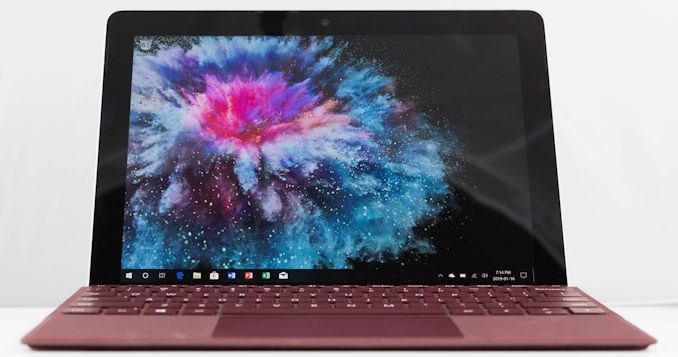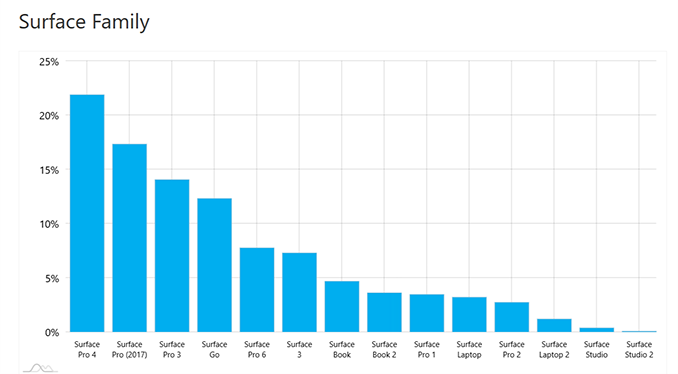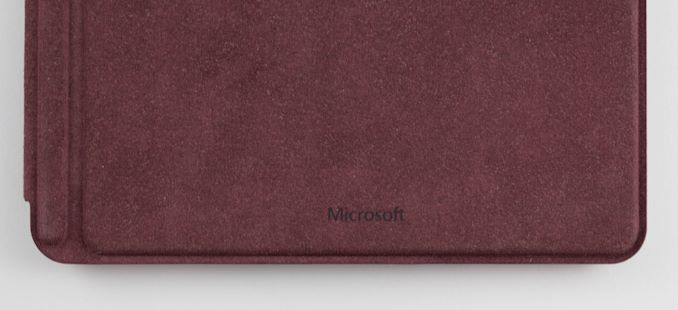The Microsoft Surface Go LTE Review: Unmatched Mobility
by Brett Howse on January 17, 2019 8:00 AM EST
Microsoft’s Surface Pro lineup has been a design win for the company for several years now. The Surface Go was launched in July of 2018 as a lower-cost version of the Surface Pro, offering buyers a less expensive way to become a Surface customer, and by the nature of its smaller size compared to the Surface Pro, an even more portable convertible Surface tablet. When the device was initially announced, a model with LTE connectivity was also in the works, and the Surface Go LTE arrived in November 2018.
Featuring a 10-inch display, the Surface Go is quite a bit smaller than the Pro, and the obvious comparison to make would be against the Surface 3, which launched way back in 2015. In the three year gap between these models, Microsoft had seemed to abandon the idea of the smaller convertible tablet in their lineup. But thanks to the smaller price tag, it was always a popular model, and it is great to see them reintroduce the reduced size Surface again. Even though the Surface 3 launched way back in 2015, it still has a usage share higher than any Surface launched outside of the Pro models, and now the Surface Go.

Source: AdDuplex.com
Looking at numbers from AdDuplex from December 2018, it makes it clear why the Surface Go was launched. And despite it only being on the market for about five months, it’s clearly gained a lot of traction in the Surface market, with usage share outstripping that of every other non-Pro model ever launched. We never got a chance to review the original Surface Go, but Microsoft has sent us the Surface Go LTE model for a full review.
The Surface Go LTE offers the benefit of always-on connectivity – assuming you have cellular coverage of course – and this opens it up to an even wider audience of customers. Microsoft is clearly aiming the Surface Go LTE at business customers looking for a small device they can take on-site, with an even smaller footprint than the Surface Pro LTE, and a lighter form factor. As has been the case with the last couple of LTE variants for Surface, the Surface Go LTE utilizes a Qualcomm X16 modem.
The rest of the Surface Go is unchanged. It’s still powered by the dual-core Intel Pentium 4415Y processor, and has the same 10-inch 1800x1200 3:2 PixelSense display. The only real difference is that the LTE variant is only available with 8 GB of RAM and 128 GB of SSD storage. The 4 GB / 64 GB eMMC model cannot be purchased with LTE.
| Microsoft Surface Go | |||||
| Surface Go Specifications | |||||
| CPU | Intel Pentium Gold 4415Y (Kaby Lake-Y) 2 core, 4 thread, 1.6 GHz base frequency |
||||
| GPU | Intel HD 615 24 EUs 850 MHz boost frequency |
||||
| Display | 10-inch PixelSense 1800x1200 3:2 aspect 216 Pixels Per Inch 10-point Multitouch Surface Pen support |
||||
| Dimensions | 245 x 175 x 8.3 mm 9.6 x 6.9 x 0.33 inches |
||||
| Weight | 522 grams (WiFi) / 532 grams (LTE) 1.15 lbs (WiFi) / 1.17 lbs (LTE) |
||||
| RAM | 4 or 8 GB LPDDR3-1866 | ||||
| Storage | 64 GB eMMC 128 NVMe SSD optional 256 GB NVMe SSD (Commerical Option) |
||||
| Wireless | 802.11ac with Bluetooth 4.1 Qualcomm Snapdragon X16 LTE Optional |
||||
| Battery | Up to 9 hours of video playback 24W Charger |
||||
| Cameras | Windows Hello IR camera 5 MP Front Camera with 1080p video 8 MP Rear Camera with 1080p video |
||||
| Ports | USB Type-C 3.1 Gen 1 with power delivery Surface Connect MicroSD Headset |
||||
| Price | 4GB/64GB $399 4GB/128GB $499 8GB/128GB $549 8GB/128 GB LTE $679 Windows 10 Pro $50 extra |
||||
The Surface Go offers many of the same features as its larger siblings, including the Surface Connect port for charging and data. This is a big upgrade over the Surface 3, which only offered micro USB charging, and the Surface Go ships with a 24-Watt AC adapter. The advantage for business customers here is that the Surface Go will work with the same Surface Dock as the rest of the lineup, meaning it can easily be connected to power, displays, and Ethernet on the desk, and then with one magnetic connector, becomes instantly portable.
The Surface Go also offers USB Type-C, which is a huge advantage for the Surface Go compared to the Surface Pro, since you can use any Type-C charger while on the road with the Surface Go. It does lose the USB Type-A port that is a key feature of the Surface Pro, but on a portable device like this, that is a worthwhile trade-off. If you need Type-A, you can of course get an adapter for Type-C, or use the Surface Dock.
It's been quite remarkable to see just how popular this device is in the market, despite it only being available for a few months. Let’s dig into the Surface Go LTE.











79 Comments
View All Comments
eastcoast_pete - Thursday, January 17, 2019 - link
Independent of this or other LTE-enabled tablet, laptop or 2-in-1s, there is a major obstacle that has hog-tied the entire concept of always-connected computing: the ridiculously overpriced LTE data plans. At least in the US, a one year data plan with actually usable data limits can easily be more than this Surface fully decked out. That's why 5G is really not that interesting; even if it is as speedy as its proponents promise, it just means that we can now blow through a whole month of data allotment in less than one battery charge. Until data plan pricing comes down a lot, these otherwise enticing always-connected devices will remain niche products.The_Assimilator - Friday, January 18, 2019 - link
Y'all need to fix your oligarchy.ads295 - Saturday, January 19, 2019 - link
So true. Just prepaid for unlimited calls, texts and 1.5GB data a day (unlimited after but throttled). Paid about USD 23.ads295 - Saturday, January 19, 2019 - link
That's for a yearly plan btw.Gunbuster - Monday, January 21, 2019 - link
Whats the real sales pitch for always connected again? Super road warriors already have this figured out with phone or MiFi type hot spot so you are trying to sell to a niche within a niche...damianrobertjones - Monday, January 28, 2019 - link
This still doesn't stop people going on and on and on and on and on about the Surface 'Pro' line not having lte.DillholeMcRib - Thursday, January 17, 2019 - link
I really hope Microsoft gets off the Intel Kool-Aid soon and switches to AMD. They could offer a cheaper device with better graphics performance.And, also, I hope they finally get Windows on ARM to a level where emulation is not such a downer, as I would buy one of those straight up for the right price.
TheinsanegamerN - Thursday, January 17, 2019 - link
Given how poorly the Go already fares in the battery life department, and how much worse ryzen mobile has been on battery life, I wouldnt hold my breath anytime soon.The_Assimilator - Friday, January 18, 2019 - link
> I really hope Microsoft gets off the Intel Kool-Aid soon and switches to AMD. They could offer a cheaper device with better graphics performance.The only one drinking Kool-Aid here is you, because AMD doesn't have any CPU at this level of low power consumption.
HStewart - Saturday, January 19, 2019 - link
Keep dreaming - with Sunny Cove around the corner. On both AMD and ARM fronts.